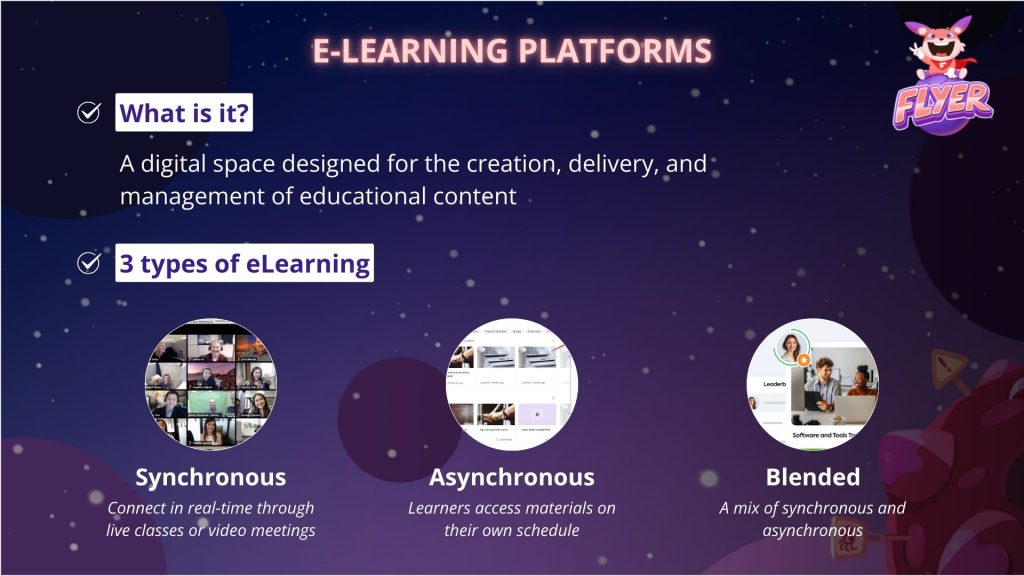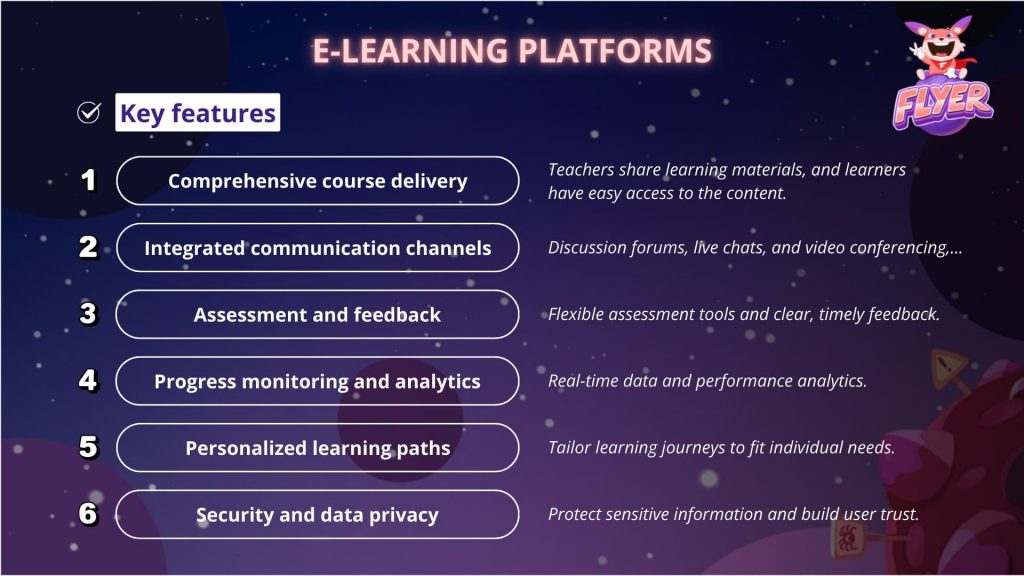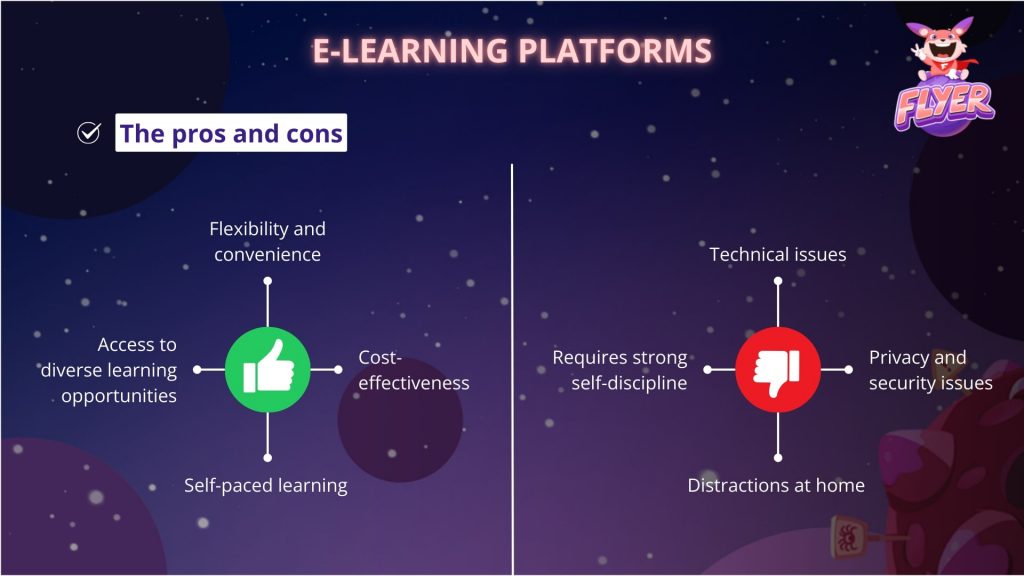eLearning platforms have grown rapidly with the rise of EdTech, especially since the COVID-19 pandemic. These platforms are continuously evolving, providing more powerful and user-friendly features. So which platforms are most trusted for teaching and learning English in 2025? And how can teachers and educators select the best platform to meet learners’ needs? Let’s explore in the article below!
5 BEST eLearning platforms for English learning:
| Platform | User Rating | Pricing |
|---|---|---|
| FLYER.us | ★★★★☆ | Free plan available; paid plans from $5/ month |
| Duolingo | ★★★★☆ | Free; Duolingo Plus starts at $6.99/ month |
| Memrise | ★★★☆☆ | Free; Pro plan from $8.49/ month |
| Lingoda | ★★★★☆ | From $8.50/ class; refund option with consistent study |
| Busuu | ★★★★☆ | Free; Premium plan from $5.41/ month |
1. What is an eLearning platform?
An eLearning platform is a digital space designed for the creation, delivery, and management of educational content. These platforms provide tools that allow teachers to offer both live and self-paced learning, expanding education beyond traditional classrooms.

eLearning platforms are generally categorized into three main types:
- Synchronous learning: Teachers and learners connect in real-time through live classes or video meetings. This approach supports immediate feedback and fosters a strong sense of community, though it requires all participants to be available at the same time.
- Asynchronous learning: Learners access materials such as videos, readings, and quizzes on their own schedule. This method offers flexibility and is well-suited for busy learners, though it requires a high level of self-discipline.
- Blended learning: A mix of synchronous and asynchronous methods, combining live interaction with self-paced study. It brings the best of both worlds, enhancing engagement while keeping flexibility.
Whether for K12 education, higher learning, or continuous professional development, eLearning platforms play a crucial role in creating flexible, accessible, and future-oriented learning opportunities.
2. Key features of an eLearning platform
Understanding an eLearning platform’s main features is essential to ensuring it meets the needs of both teachers and learners. Here are some key features to look for.
| No. | Key features | Details |
|---|---|---|
| 1 | Comprehensive course delivery | – Teachers can share a wide range of learning materials, from videos and slide presentations to interactive lessons. – Learners have easy access to engaging, high-quality content anytime, anywhere. |
| 2 | Integrated communication channels | Support effective communication through features such as discussion forums, live chats, and video conferencing, allowing for both real-time and flexible learning experiences. |
| 3 | Reliable assessment and feedback | – Offer flexible assessment tools whether through short quizzes or full assignments. – Provide clear, timely feedback to help learners improve and stay on track. |
| 4 | Progress monitoring and analytics | With built-in tracking tools, teachers can monitor learner progress, identify learning gaps, and make effective decisions based on real-time data and performance analytics. |
| 5 | Personalized learning paths | Using smart technologies such as AI, many platforms tailor learning journeys to fit individual needs – boosting student motivation, relevance, and learning effectiveness. |
| 6 | Security and data privacy | Strong security measures, such as data encryption and secure authentication, help protect sensitive information and build user trust. |

3. The pros and cons of using an eLearning platform
While these platforms offer flexible learning experiences and a wide range of tools to support teaching, they also come with certain challenges that teachers and educators should consider.
3.1. Benefits of using an eLearning platform
| Flexibility and convenience: Allow learners, especially adult ones or those with busy schedules, to access courses anytime and anywhere. |
| Cost-effectiveness: Help learners save on transportation, housing, and physical materials. |
| Self-paced learning: Enable learners to learn at their own pace. They can revisit lessons or move ahead as they feel confident. |
| Access to diverse learning opportunities: Offer various courses and materials that fit different goals and learning styles. |
| Environmental benefits: eLearning reduces the need for paper, textbooks, and daily travel, which contributes to less waste and lower carbon emissions. |
| Global collaboration opportunities: Learners from around the world can study together, build teamwork skills, and gain cultural understanding. |

3.2. Challenges to consider when using an eLearning platform
| Technical issues: eLearning depends on technology, so issues like weak internet or software errors can disrupt the learning experience. |
| Requires strong self-discipline: eLearning demands a higher level of self-motivation and time management from learners. For those who struggle with these skills, it may be challenging to stay focused and keep up with their studies. |
| Distractions at home: Learning in a non-traditional setting, such as at home, often comes with more distractions. To support focus and productivity, a structured environment is essential. |
| Equity concerns: Some students may not have the same access to essential technology or a stable internet connection. This can lead to unequal learning experiences and make it harder for them to take part fully in online lessons. |
| Privacy and security issues: As more learner data is stored online, concerns about privacy and the security of personal information grow. Teachers and educators need to ensure that platforms they use protect learners’ data properly. |
4. 5 BEST eLearning platforms for English teaching and learning
Following the exploration of the benefits and challenges of eLearning platforms, here are the 5 best eLearning platforms designed specifically for English language teaching and learning.
| Platform | Best for | Key Features & Flexibility | User Rating | Pricing |
|---|---|---|---|---|
| FLYER.us | Cambridge English (Starters, Movers, Flyers), KET, PET, TOEFL Primary, TOEFL Junior | Real test simulations, automatic scoring, detailed reports, child-friendly interface. | ★★★★☆ | Free plan available; paid plans from $5/ month |
| Duolingo | Daily English communication, basic language skills | Gamified lessons, short and easy-to-follow modules, mobile-friendly, progress tracking. | ★★★★☆ | Free; Duolingo Plus starts at $6.99/ month |
| Memrise | Vocabulary, conversational phrases, listening practice | Flashcards with images and native-speaker videos, community-contributed content, offline mode (paid). | ★★★☆☆ | Free; Pro plan from $8.49/ month |
| Lingoda | IELTS, TOEFL, Business English, intensive communication | Live 1-on-1 or small group classes with native teachers, structured learning paths. | ★★★★☆ | From $8.50/ class; refund option with consistent study |
| Busuu | General English from A1 to C1, speaking and writing practice | Interactive lessons, peer feedback, personalized study plans, McGraw-Hill certificate. | ★★★★☆ | Free; Premium plan from $5.41/ month |
5. How to choose the right eLearning platform?
Every eLearning platform has its own strengths and limitations. The key is to find the right one that maximizes benefits and minimizes drawbacks, helping increase the effectiveness of English language teaching. To choose the most suitable platform for English teaching and learning, teachers may consider the following factors:
6. Changes in eLearning platforms: 2024 vs. 2025
In addition to the factors mentioned above, it is essential to consider current trends when selecting an eLearning platform. Staying updated with the latest eLearning trends helps ensure effective English language teaching and the best learning experience for learners. Compared to 2024, eLearning has made significant advancements in the following areas:
| 2024 | 2025 | |
|---|---|---|
| AI and Adaptive learning | AI started being integrated into eLearning platforms to analyze learner data and adjust content to better match individual needs. | AI became more advanced, offering 24/7 virtual assistants, real-time feedback, and comprehensive personalized learning paths for each learner. |
| Virtual Reality (VR) and Augmented Reality (AR) technologies | VR and AR were introduced to create simulations and virtual labs for a more visual learning experience. | VR and AR were widely used, providing immersive learning environments and virtual spaces for collaborative group work. |
| Microlearning and Nano-learning | Microlearning grew popular, offering short, easy-to-access learning modules suitable for busy lifestyles. | Nano-learning emerged, delivering ultra-short learning units (often under two minutes, shorter than microlearning lessons), personalized with AI to boost learning efficiency. |
| Gamification | Gamification was used by adding points, badges, and leaderboards to motivate learners and increase engagement. | Gamification evolved into “Gamification 2.0,” introducing immersive role-playing games, multi-player simulations, and instant feedback mechanisms. |
| Hybrid learning | Hybrid learning models were introduced, combining online and face-to-face learning experiences. | Hybrid learning became the standard, supported by interactive tools like virtual whiteboards, live polls, and breakout rooms for more flexible education. |
| Inclusion and accessibility | Efforts to improve accessibility for all learners started to gain attention. | Learning platforms fully integrated assistive technologies, including text-to-speech, automatic subtitles, and responsive designs for various devices. |
7. FAQs about eLearning platforms
eLearning, or electronic learning, involves using digital platforms and devices to deliver educational content. It enables learners to access lessons, videos, quizzes, and interactive tools online, making education more accessible and adaptable to individual needs.
An example of eLearning is Google Classroom, a free web service developed by Google. It allows teachers to create, distribute, and grade assignments, facilitating communication between teachers and learners.
Both online learning and eLearning involve education delivered over the Internet. However, eLearning covers a wider range of electronic learning methods, utilizing various digital tools and resources, including both online and offline formats. Online learning, on the other hand, specifically refers to education conducted solely over the internet.
Effective eLearning incorporates visuals, clear learning objectives, interactive elements, and opportunities for practice. This ensures content is focused and simplified, improving the learning experience for learners.
eLearning offers flexibility by allowing learners to use digital platforms and access content remotely at their own pace. In contrast, traditional classroom learning typically involves in-person instruction with fixed schedules and locations.
Conclusion
To sum up, integrating eLearning platforms into teaching is a step educators should consider as we move toward the era of digital education. Despite the challenges that may arise early on, the transition also brings new opportunities, so it’s important for teachers to stay steady and make the right choices along the way. Hope this article is helpful for your journey ahead.
You may also like



